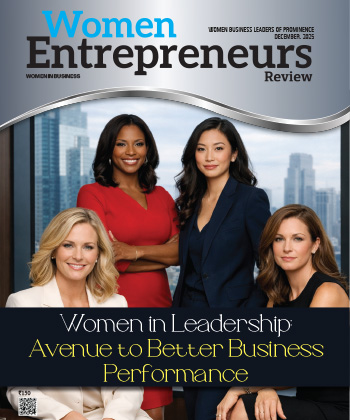
Mentoring Women Creates Supportive & Inclusive Environment at Work
By: Bindiya Bhatt, Senior Director, Myntra
Bindiya Bhatt is a business leader with over 14 years of experience in the e-commerce and fashion retail sector. She brings extensive domain expertise and a strong passion for innovation, constantly seeking to redefine strategies in a rapidly evolving environment. With a background in e-commerce since its early stages in India, she possesses a deep understanding of zero to one scale-up initiatives spanning the entire customer journey.
In a recent conversation with Women Entrepreneurs Review magazine, Bindiya talks about the significance of mentorship and sponsorship in advancing women’s career advancement. She also talks about mentoring, sponsorship, ensuring pay and promotion transparency, and addressing challenges hindering women’s progress.
Mentorship and sponsorship are very important in fostering career growth. Can you please explain how you mentor and sponsor women within the organization to help them climb the leadership ladder?
Mentoring and sponsoring women within the organization is by creating a supportive and inclusive environment where they can thrive, feel seen and understood and reach their full potential as leaders.
Firstly, Role Modeling to help inspire and motivate other women to pursue leadership positions and reinforce the message that success is attainable.
I am also a huge believer in addressing unconscious bias. These biases are often deeply ingrained in societal norms and cultural expectations, and they can manifest and many times leads to missed opportunities for women.
Other than that the only women Forums and inclusive forums where open discussions around the same happen to enable discussions around the issues faced by women and how to support and enable the same across.
Transparency in pay and promotion processes is critical for addressing gender disparities. How would you ensure transparency and equity in these processes within the organization?
We have fairly standardized processes where we ensure that gender disparity isn’t playing out while holding managers and leaders accountable for promoting transparency and equity in pay and promotion decisions. Monitor progress towards goals and address any issues that arise is critical at every stage. Furthermore, I advocate for open dialogues with women to ensure they perceive open communication and remain informed about organization-wide developments.
In your opinion, what are the key challenges that women face in reaching senior leadership positions, and how would you address them?
In my opinion, some key challenges that women face in reaching senior leadership positions include gender bias and stereotypes, limited access to mentorship and sponsorship opportunities, and work-life balance issues, particularly for those with care giving responsibilities.
To address these challenges, I would advocate for creating a more inclusive and supportive organizational culture that promotes diversity and equality. This could involve implementing diversity training programs, establishing mentorship and sponsorship initiatives specifically tailored to support women's career advancement, and offering flexible work arrangements to accommodate diverse personal and professional needs.
Also there’s a challenge for women to ask for what they deserve which stems from various factors, including societal expectations, cultural norms, and internalized beliefs about self-worth. Women may feel hesitant to advocate for themselves due to fear of being perceived as aggressive, or they may lack confidence in their abilities compared to their male counterparts.
Additionally, promoting greater transparency in recruitment, promotion, and compensation processes can help mitigate unconscious bias and ensure equal opportunities for women to advance into senior leadership roles.
How do you prioritize diversity and inclusion within your leadership approach, particularly concerning the advancement of women in the workplace?
Prioritizing diversity and inclusion within my leadership approach, especially concerning the advancement of women in the workplace, involves five key things:
Clear Goals and Commitments: Establishing clear diversity and inclusion goals and making a public commitment to advancing women in leadership roles sends a strong message of organizational values and priorities.
Inclusive Policies and Practices: Implementing policies and practices that promote diversity and inclusion, such as flexible work arrangements, equal pay, and zero tolerance for discrimination, ensures that the workplace is welcoming and supportive for women.
Providing Development Opportunities: Offering leadership development programs, mentorship initiatives, and networking opportunities specifically tailored to women's needs helps them build skills, confidence, and networks necessary for career advancement.
Ensuring Equitable Opportunities: Ensuring that women have equitable access to career advancement opportunities, including promotions, stretch assignments, and high-profile projects, helps to level the playing field and break down barriers to advancement.
Addressing Unconscious Bias: Providing training and education on unconscious bias helps leaders recognize and mitigate biases that may impact decision-making processes related to hiring, promotions, and performance evaluations.
Intent is to create a culture where all employees feel valued, respected, and empowered to reach their full potential.
Most Viewed
- 1 Women's Health Startup HerMD Closing Doors Amid Industry Challenges
- 2 5 Famous Women in Indian Armed Forces
- 3 Saudi Women No longer Require Male Permission for Clothing Choices, says Prince MbS
- 4 Kolkata Medtech Startup Innovodigm Raises Rs 5.5 Crore Seed Funding Led by IAN Group
- 5 Yamunanagar's Kashish Kalra Honoured after Securing 111th Rank in UPSC Civil Services Exam
- 6 Madurai Appoints Its First Woman Corporation Head
- 7 IAS Vijayalakshmi Bidari Appointed as the new Nagpur Divisional Commissioner
- 8 American Entrepreneur Lucy Guo Overtakes T Swift to become Youngest Female Billionaire
- 9 ICC Women's World Cup 2025 Trophy Showcased at Indore's Holkar Stadium
- 10 Aparna Saxena's Beauty Venture AntiNorm Launches in India
- 11 Vidya Nataraj Co-Founded BlueStone Jewellery & Lifestyle files IPO
- 12 5 Women Freedom Fighters of India
- 13 Dr. G Krishnapriya appointed as CEO for Trichy
- 14 M3M & Sirona Partner to Introduce Menstrual Hygiene Vending Machines in 15 Locations
- 15 Punjab Govt launches SHE Cohort 3.0 Supporting Tech-led Women Startups
- 16 Indian origin Lawyer, Sweena Pannu appointed as the US New Superior Court Judge
- 17 The Aurora Tech Award recognizes 4 Indian Women-led Startups
- 18 Kerala's Republic Day parade featured an all-female tableau
- 19 Manisha Kabbur Becomes Karnataka's First Woman International Karate Coach
- 20 Director K. S. Ravikumar's Daughter Maalica Ravikumar Launches Life Coaching Company 'Evergrowth Academy' for Women
- 21 Leezu's Raises Pre-Seed Funding to Accelerate Growth in Sexual Wellness Industry
- 22 Sattu: Super-easy summer drink for PCOS gut healing
- 23 Swathi Nelabhatla creates Sitha App, India's First Women-Exclusive Gig Platform
- 24 7 Timeless Female Kathak Dancers & their Iconic Legacies
- 25 Meet 7 Iconic Women Architects of Modern India & their Most Impactful Work
- 26 This Woman-led Insuretech Startup is Helping Bridge the Education Financing Gap in India
- 27 Women Leaders Share Lessons Learnt from India Women's WC Win
- 28 5 Enterprising Women Founders Powering Singapore's Tech & Innovation Landscape
- 29 4 Women. 4 Stories. One Vision for Smarter, Stronger Healthcare
- 30 Global Gender Gap Narrows to 68.8%, But Full Equality 123 Years Away: WEF Report 2025
- 31 Changemakers: 7 Women Entrepreneurs Taking the Make in India Movement Forward
- 32 Meet Lucy Guo, The Youngest Self-Made Female Billionaire Disrupting Tech
- 33 How Women are Driving India's Festive Online Shopping Surge






